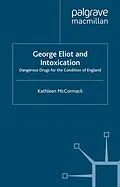Throughout George Eliot's fiction, not only do a remarkable number of her characters act under the influence of unwise consumption of alcohol and opium, but drugs also recur often as metaphors and allusions. Together, they create an extensive pattern of drug/disease references that represent socio-political problems as diseases in a social body and solutions to those problems (especially solutions that depend on some kind of written language) as volatile remedies that retain the potential to either kill or cure.
Autorentext
Kathleen McCormack is Associate Professor of English in the State University System of Florida.
Inhalt
Preface Acknowledgements George Eliot and Victorian Intoxication Backgrounds and Landscapes The Early Fiction Public Houses: Unstable Language in Dangerous Places Parables of Addiction Romola: San Buonvino Felix Holt's Muddled Metaphors Middlemarch: 'Profit Out of Poisonous Pickles' Daniel Deronda: After the Opium Wars Epilogue Bibliography Index
